A smart home is a home that uses the latest electronic technology and computerization to control or automate many different aspects. Implementing such facilities requires some basic thoughts on design and technology.
The range of different smart home devices and technologies available is rapidly expanding with the development of computer controls and sensors. This has inevitably led to compatibility issues and therefore there is a need to standardize home automation technologies and protocols. In Europe, the Installation Bus or Instabus protocol is becoming the recognized smart home technology protocol for digital communication between devices

There are four very practical reasons why people invest in smart home technology. These include:

Every smart home differs in what it does and how it handles it, but in general, the measure of a “good” smart system is the degree to which it improves your home and how unobtrusively it accomplishes that.
There’s no point in having technology for technology’s sake – if managing your smart home systems requires more time, cost, and effort than it would take to do it manually, you might as well do it yourself or hire a housekeeper.
If your air conditioning systems are automated, for example, they should constantly adjust to keep you comfortable in your home exactly where you need it. Ideally, this should be done unobtrusively and with maximum efficiency. You should also be able to change the automatic settings easily and quickly, without having to struggle with complicated controls or trek to the other end of the house to do so.
>> Read also: A smart home – or what kind of home?
Most smart homes use smart wiring or a specially built home network to allow different parts of the house to communicate with a central control system. Timers, switches and sensors are used to determine when and how various automated systems should operate, and different “scenes” and events can be set up to implement different controls for different scenarios.
For example, when you come home from work, a sensor may detect that you are home and turn on certain lights, deactivate various security measures, and heat the living room. When you go to bed, it can activate security sensors, draw all the curtains, and turn off lights and other devices.
No matter what kind of system you plan to install, it’s always a good idea to talk to installers first. Not only will they be able to advise you on what type of system will best suit your needs, but they will also help make sure that it is installed in the most efficient and cost-effective way.
Like most things that make life easier, turning your home into a networked home comes at a price. Simple systems can be installed relatively inexpensively, but obviously the more you can afford, the more extensive, secure and functional your system will be. Your budget is the only real limit to what you can do to make your home a “smart home”.